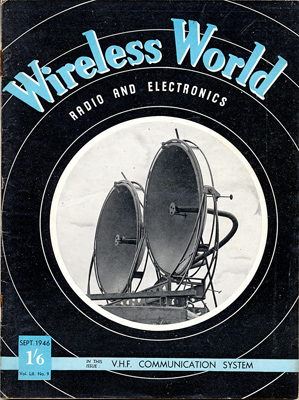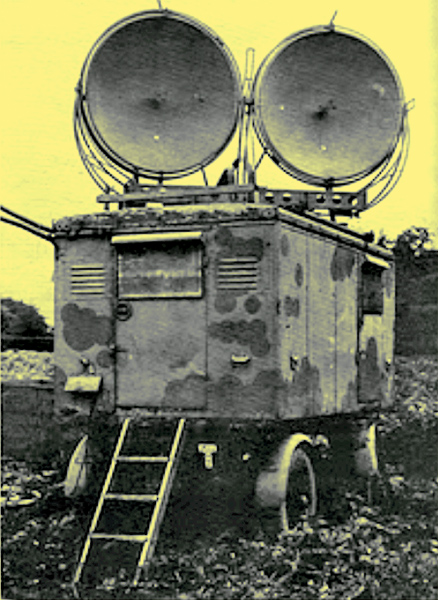|
Centimetre waves, Pulse modulation and multi channel.

The No.10 set was featured in September, 1946. The parabolic dishes appeared on the cover.
Soon after D-day the Army brought into use a piece of wireless equipment which was unique in the history of military communications. It was unique in that it combined the security from interception of the line circuit with the flexibility of wireless, and it achieved this primarily through the use of centimetre waves.
The military user of wireless communication has continually at the back of his mind the danger of enemy interception, and he has to regulate his use of wireless accordingly. There has consequently been in the past an understandable preference for line communications with which the chances of interception are much smaller.
The great drawbacks to lines, however, are the man-power and time needed for their erection and maintenance, and their vulnerability to enemy action. This will be realised when it is remembered that a line of only 20 miles requires the erection of some 700 poles for its support. The impossibility of erecting line circuits to follow up a rapid advance, such as that through France, is self-evident. It is here that centimetre-wave wireless steps in. Because of the peculiar properties of such waves, almost complete freedom from interception can be obtained, and yet a circuit can be established so quickly that communications can keep pace with the most rapid advance.
Centimetre Waves
The great advantage of the No. 10 set - its freedom from enemy interception - is secured through what is often considered to be a drawback of centimetre waves. This is the fact that their laws of propagation are very similar to those of light. Radiation progresses along substantially straight-line paths, and it is interrupted by any sizeable obstacles in its way. It is, however, unaffected by fog and rain, and it takes but little notice of small obstacles.
In addition, the aerial can be large in terms of wavelength while still small physically, so that the radiation can be confined to a narrow beam, not unlike that of a searchlight. It is easy to see that under these conditions enemy interception is virtually impossible unless the beam is pointing straight at his territory. This, of course, cannot always be avoided, for one naturally desires to work to and from one's own lines, but it is here that the liability of centimetre waves to interruption by obstacles comes in. By siting the station so that there is a hill between the receiver and the enemy the signal can be prevented from reaching him.
By the use of beams and by choosing sites so that there are hills to block the beam from the enemy, it is not difficult to secure freedom from interception. It should be noted, too, that these same factors also prevent mutual interference between one's own sets - a very important point in peace as well as war.
The range obtainable is limited chiefly by the terrain, for while it is desirable to site stations so that hills interrupt the beam beyond the receiver, it is necessary to site them so that it is not interrupted along the required path. The range depends more on the nature of the country than on the equipment, therefore, and is usually about 20 miles. It is, however, sometimes well over 50 miles.
The use of centimetre waves confers another advantage. Ether space is not restricted, and large band-widths can be used. This in its turn permits the use of pulse modulation, and this is very desirable if only because it lends itself to a particularly simple form of multi-channel operation.
The No. 10 set is designed to handle eight speech channels simultaneously. The transmitter accepts the audio signals from eight lines, arranges for each channel to modulate a train of pulses, mixes the eight trains, and radiates bursts of RF energy corresponding to the pulses. The receiving equipment performs the inverse function; it sorts out the received pulses, routes them to their correct channels and demodulates them into the audio signals again.
The complete No. 10 set station is housed in a four-wheel trailer and is thus readily transportable. Circular mirrors form the aerials and are mounted on the roof, but if additional height is needed, a special transportable 60 ft. tower can be employed to carry the mirrors.
The sets work in pairs to provide eight duplex telephone channels, and long distances can be covered by using relay stations. Great use was made of such relays on the Continent, and on at least one occasion no fewer than ten links were used to connect Luneberg and Brussels. At Brussels the circuit joined the normal land line. Direct communication between Luneberg and Whitehall was thus maintained by a mixture of centimetre-wave wireless and ordinary land line.
Development and Use
The idea of the No. 10 set first arose as far back as 1941, and the credit must go chiefly to W A S Butement, A V Oxford, E W Anderson and J G Macmillan of the Ministry of Supply. In 1942 the first experimental two-stage link was set up between Horsham and the roof of Berkeley Court in London. Later trials were carried out on an overseas path from Ventnor, Isle of Wight, to Beachy Head, and then, just after D-day, came the first operational link - between Ventnor and Cherbourg. Thereafter, No. 10 sets followed the advance. For several weeks they provided the only speech communication over the Maas and the Rhine; Field Marshal Montgomery's Tactical HQs. were never out of touch with the whole of 21 Army Group and the War Office for more than one hour.
The security obtained was absolute, for although after the surrender the Germans claimed to have intercepted our wireless transmissions with ease, careful examination showed that they had never intercepted No. 10 set signals, and were completely unaware that we even possessed such equipment.

The No.10 set.
|